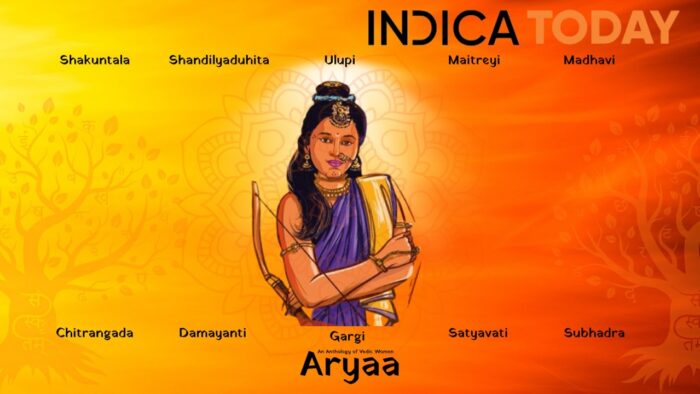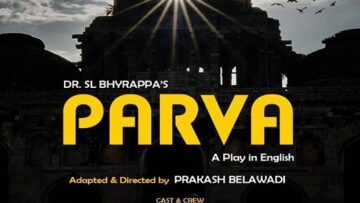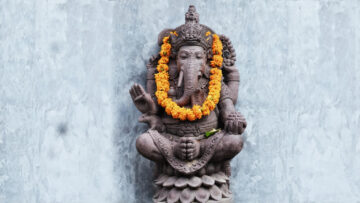(An extension of the Preface of the Book – “Aryaa – An Anthology of Vedic Women)
Indic Scriptures and Epics are philosophical treatises which contain frameworks for building good societies and individual lives. They espouse the cause of Purushartha and strive to create Dharma consciousness in our minds. Our Scriptures and Epics serve as civilizational encyclopedias — they store our perspective of life, intellectual thought, and contemplations on various matters.
Our epics throw light on the kind of social organization, social relationships and social entities that have been nurtured over millennia, shaping our civilization across the centuries, both consciously and subconsciously. Our Epics may not be exact histories in the sense the word history is used by the modern world. However, the ruminations and lived experiences from within society have shaped these stories. They were ideals that the society sought. And one important aspect of these stories is the characterization and depiction of women.
Hindu Epics present fascinating, inspiring, dynamic and independent women, each one a woman of substance. The imagination of women and the status they had in these accounts throw light both on our ancient society and the civilizational history of India. The roots of this dynamism lie in the philosophy of our parampara. The dynamic of the universe is represented by both Devi and Devata. In addition, our philosophy has always influenced life on the ground.
Striving for our chosen Purushartha, we serve both an individual and a social purpose unique to us, under the influence of Karma and within the limits of our Time, Space and Context (Desha-Kala-Patra). Hence, in our Epics we see divine, dynamic and marvellous women (and men). We see this throughout our history — from Gargi to Satyavati to Prabhavati Gupta to Devi Ahalyabai Holkar. In both peaceful and troubled times, Bharatavarsha has had inspiring women.
Great women from our epics — such as Savitri, Kunti, Satyabhama and Draupadi — are well known. They come across as independent, knowledgeable, intellectual, thoughtful, valorous, assertive and conscious influencers in their world and times, participating in worldly affairs including administration and warfare. Their influence on our civilization is profound. But lesser-known women characters of our epics are equally fascinating. For instance, in the Udyoga Parva of Mahabharata, Sage Shandili appears as part of a small story. However, she teaches an important lesson to Garuda that even an incorrect thought has its consequences and can bring down our strength obtained through years of penance and serving the divine.
Sadly, in the recent past, we have witnessed a diametrically opposite portrayal of our sheroes from the Epics. For instance, Vyasa’s Savitri in Mahabharata is a wise, witty and brave lady with a distinct personality of her own. She makes her own choices. Modern retellings have unfortunately interpreted Sati Savitri as a victim. This necessitates that we revisit the portrayal of Bharat’s sheroes through rewrites and retellings that are loyal to rishis like Vyasa Deva and bring back the essence of our civilization.
We need narrations that inspire fresh academic and cultural conversations in our universities and society. We need a body of work and perspective that influences and adds to the discourse of civilizational theories and cultural studies. We need literature that engages with our readers to bring them the essence of our civilizational thought. We need a dialogue that sparks Indic Civilizational Consciousness. We need to present in front of our children the ‘Indian Feminine – Shakti’ that seeks harmony through strength, the divinity in front of which the masculine bows.
The Book “Aryaa – An Anthology of Vedic Women” is a step in this direction. It consists of 10 Stories on 10 Vedic Women written by 10 different Authors. It is a retelling of the stories of women characters from the Vedas, Upanishads, Itihasa-Puranas and Mahakavyas. It is a creative reimagination within the context of our philosophy, the essence of our tradition, and the boundaries of the original text. It is a labour of love and effort, and of conviction that our civilization and our past is an inspiration for all times to come. In some ways, this is our tribute to Bhagavan Veda Vyasa as well. The Vedas, Upanishads, Mahabharata, Puranas are with us today in the form and organization decided by Vyasa Deva.
The stories bring out the essence of chosen women characters from the epics so that they can be an inspiration for the current times. They throw light on our civilization and the social ecosystem that shaped such characters. They ignite that spark which makes us reimagine our past in the light of the principles of Sanatana Dharma, free from imposed thought and world view. They compel us to understand our tradition in greater depth and strive for that important value, Saatatya: continuity with our civilization and an integrated view of the past, present and future.
Aryaa has many faces. She plays different roles in different times, embodying the essence of our tradition that has at its core, harmony and alignment with the cosmic ways. Whether pursuing her innermost calling or pulling her people out of unimaginable emergencies and difficult circumstances, Aryaa has always carved a niche for herself, charted her own path, upheld Dharma and shaped our civilization. As Chitrangada, she lived the life of a warrior and an heir apparent, leading from the front, protecting her kingdom and people. As Damayanti, she waded through treacherous destiny and restored her husband back to glory with her unflinching love and wit. As Shakuntala, she raised Sarvadaman to be the great emperor Bharat, our civilizational anchor and to give him his due she did not hesitate to challenge even a king in his court. As Subhadra, she kept her grief aside when all her people were dead and gone to guard the Nara-Narayana legacy and the Kuru throne till the heir apparent was mature enough to take up his social role. As Madhavi, she saved four royal dynasties, and opened the doors of Swarga that even Rishi Viswamitra couldn’t. Aryaa also came from different social strata. She was Matsyagandhi, the upfront and wise fisherwoman who rose to be Satyavati, the Queen Mother of Hastinapur who navigated many challenges and shaped the destiny of the Kuru dynasty and the Aryavarta with her tough decisions and steely resolve. As Ulupi, she led a quiet life on her own terms, choosing to stay on the margins but always shaping life at the centre. Aryaa has always been a great seeker. As Gargi, she courageously pursued truth, unafraid to challenge the greatest scholar of her time on nuances of metaphysics. As Maitreyi, she was the wind beneath her husband’s wings and when he pursued the ultimate truth, she too walked the unyielding path giving up all her material security. As Shandilyaduhita she sought an improbable marriage and the power of her penance and devotion fetched her and her husband a surreal union on earth and an afterlife in Indra’s much sought domain.
With deep reverence, we present “Aryaa – An Anthology of Vedic Women” to our future generations. We trust that through these 10 stories, they would be able to connect with Aryaa – the timeless and beyond space. May this connect prove a touchstone in their lives, forever inspiring them to play it big and live life Aryaa-size.
[“Aryaa – An Anthology of Vedic Women” is a book curated by Shivakumar GV and published by Indic Academy. It consists of 10 Stories on 10 Vedic Women from 10 Authors. The Authors are Rohini Gupta, Manjula Tekal, Prasad Kulkarni, Bharathi V, Deepak MR, Madhureima Devii Dasi, Rajani Muralidhar, Celia Pillai, Kavita Meegama and Ranjit Radhakrishnan]
Disclaimer: The opinions expressed in this article belong to the author. Indic Today is neither responsible nor liable for the accuracy, completeness, suitability, or validity of any information in the article.










